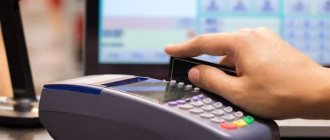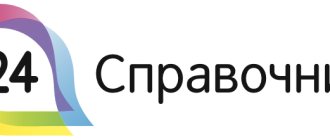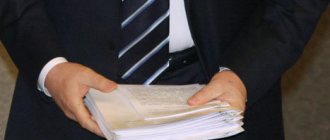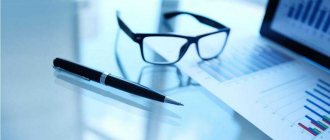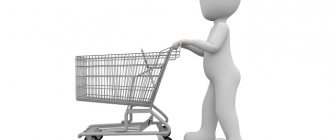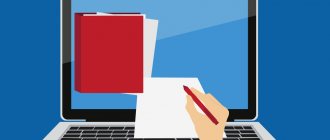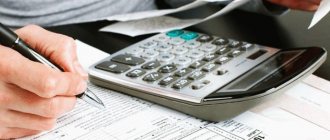If every organization in the Russian Federation registered as a legal entity is required to keep accounting records, then a balance sheet for individual entrepreneurs is not mandatory.
There are no rules for individual entrepreneurs that would oblige them to keep full accounting records, so they are freed from the need to prepare a balance sheet. A special BB system is provided for small businesses. This scheme includes reporting of income and expenses. Maintaining a balance sheet in a simplified version is not difficult, so even a novice entrepreneur should not have problems with this procedure.
Previously, the concept of a balance sheet was referred to as Form 1. And today this document is one of the most important when preparing a company’s annual report. This fully reflects the financial condition of the enterprise as of December 31 of a particular year. All this is necessary for reporting to inspection authorities, for example, to the tax service. In addition, the balance sheet helps the manager himself and TOP managers see the picture of the work done over the year, but in monetary terms. Therefore, individual entrepreneurs often create a BB to control their business.
The balance sheet, whether simplified or regular, always includes the assets and liabilities of the enterprise. The first section is a reflection of the resources that are present on the balance sheet of the enterprise. We are talking about all assets and non-current assets, including equipment, real estate and cash investments that will not be returned for more than one year. Balance sheet liabilities are any sources of financing an asset. The peculiarity of the balance sheet is that the amounts of the sections must match 100%. This is a mandatory condition, otherwise there will be no balance as such.
Features of a simplified balance sheet
This type of reporting is one of the significant advantages of small businesses. It is convenient to use for individual entrepreneurs. For legal entities there are other options, usually more complex.
Russian legislation states that small businesses include all companies that have an annual income of less than 400 million rubles, as well as a number of employees not exceeding 100 people. Companies of this type are allowed to maintain a simplified balance sheet. However, you need to remember that reporting to regulatory authorities must be submitted annually, regardless of what form of balance sheet is used.
A simplified system is a convenient and simple way to demonstrate the results of a company’s work for a certain period, namely a year.
Figure 1. Example of a simplified balance sheet.
In this way, the manager can find out about the state of affairs of the company at the end of the reporting year.
The simplified balance sheet form provides 3 separate columns where data for the new reporting period and the two previous ones are entered. As a result, it is convenient for employees of inspection bodies and company management to compare indicators for 3 years at once. This allows for a more qualitative assessment of the company's activities. An example of a simplified balance sheet can be seen in Fig. 1.
Legal provisions
Is an individual entrepreneur’s balance sheet needed or is its function performed by another document? The obligation to maintain accounting records by enterprises and organizations is provided for in the Federal Law “On Accounting”. In accordance with Article 2 of the law, entrepreneurs carrying out their activities without establishing a legal entity. persons are not required to keep accounting records.
However, the obligation to create accounting for individual entrepreneurs is secured by tax legislation. In turn, paragraph 2 of Article 54 of the Tax Code establishes a reference to the regulations of the Ministry of Finance. Therefore, the main regulatory act establishing the accounting rules for individual entrepreneurs is a special procedure established by Order of the Ministry of Finance dated August 13, 2002 No. 86n.
Clause 4 of this Procedure determines that accounting in individual entrepreneurs is carried out in a special Book (KUDiR). Therefore, to the question of whether an individual entrepreneur needs to submit a balance sheet, the answer is definitely no.
But it is worth noting that KuDiR does not have a uniform model depending on the taxation system. A natural question may arise whether it is necessary to submit the balance sheet of an individual entrepreneur under the simplified tax system or UTII. So, the simplified tax system has its own sample of KuDiR, but there is no balance, but OSNO has its own. So whether an individual entrepreneur needs to submit a balance sheet on OSNO or not, there is also a negative answer.
However, the obligation to maintain accounting records does not apply only to those entrepreneurs who are taxed according to a special system. Whereas, in general, a balance sheet is required, but only for statistics, for the purpose of maintaining statistical documents, and not for taxation purposes. At the same time, for personal purposes, any individual entrepreneur can keep accounting records.
On video: Balance sheet and explanations thereto; statement of changes in equity
https://youtu.be/pxFOoRpI-m0
How is a simplified balance sheet filled out?
As mentioned above, any type of BB consists of assets and liabilities. The simplified form is no exception. The assets column indicates absolutely all the company’s property, both tangible and intangible. Liabilities record data on the sources of asset formation. The asset contains five items, and the liability - six.
Like any other document, the balance sheet is filled out from the header. To do this, you must enter all the necessary details of an LLC or individual entrepreneur. In most cases, the header of the balance sheet indicates the OKPO code, identification number, full name of the company, type of economic activity indicating the corresponding codes and place of registration of the company or individual entrepreneur.
Figure 2. Example of filling out a simplified balance sheet.
When filling out financial statements, you need to be extremely careful. This is very important, since errors are subject to penalties from the tax office. Often the information is taken from accounts. However, one paper may contain data on both assets and liabilities, so they need to be separated and placed on separate parts of the balance sheet.
The rules for filling out financial statements do not change from year to year. This simplifies the work of the accountant and makes it possible to easily and conveniently compare information over the past years.
The balance sheet is considered a finished document only after the manager’s signature appears on it. If we are talking about an individual entrepreneur, then the entrepreneur himself signs. An example of filling out a simplified balance sheet can be seen in Fig. 2.
Accounting statements of individual entrepreneurs on UTII
Recently, there have been major changes in the application of this tax regime. First of all, it should be noted that UTII has ceased to be mandatory. Now entrepreneurs have the right to switch, for example, to the “simplified” system. Of course, the law does not prohibit remaining on UTII if all conditions for its application are met.
As in the case of the simplified tax system, an entrepreneur on UTII fills out only one declaration, but this happens every quarter. The tax return (its form KND 1152016 was approved by the Federal Tax Service by order of July 4, 2014 No. ММВ-7-3/) is submitted by the 20th day of the month following the reporting period.
UTII reporting is quite simple. To calculate the amount of tax, an entrepreneur needs to know the coefficients established by law. Once you have calculated the tax, you can simply copy the declarations. Naturally, if the working conditions remain unchanged (working hours, room size, etc.), and also if there have been no important changes in the legislation.
Also note that UTII is not subject to all activities carried out by an entrepreneur, but only some of its types. Consequently, very often an entrepreneur has to combine reporting on UTII with reports from other systems used.
Enterprise asset
It is more convenient to start filling out the BB form from the assets section. Here, data is entered into each line in accordance with the description of the column. For example, tangible non-current assets include the residual value of fixed assets and investments that have not yet been completed. Intangible, financial and other non-current assets include account balances for research and development, patenting, copyright and all investments that were made in various material assets.
Classification of enterprise assets.
Inventories are considered to be the sum of balances for accounting for raw materials and goods. This also includes fuels and lubricants, spare parts for the company’s vehicles and unfinished construction. In 2020, the rules for writing off materials changed in the Tax Code. If the company previously used the LIFO method, it must be abandoned and a replacement must be found.
In the line with monetary assets and equivalents, it is worth noting the balances of cash accounts, money in the company’s bank accounts, including special and foreign currency accounts. In addition, this line indicates money that is present in the company’s deposit accounts, but has not yet been claimed, as well as short-term investments.
In the line with financial and other current assets, information about funds that do not fall into the previous category is entered. As a rule, these are receivables for services and payment for products, investments for up to 12 months.
Accounting statements of individual entrepreneurs on a patent
Since 2014, the patent tax system has become an independent tax system. The use of the patent tax system is the prerogative of only individual entrepreneurs. No one else can use it. The regulatory document for this system is No. 94-FZ dated June 25, 2012, as well as the Tax Code of the Russian Federation Ch. 26.5.
A patent replaces the obligation to pay certain taxes. If, in addition to patent activities, the entrepreneur is engaged in activities that do not fall under this system, then there is a need to prepare reports according to another chosen system.
IP reporting on a patent is extremely simple. And it involves the entrepreneur keeping a book of income and expenses. This book is kept separately for each patent.
Expert opinion
Maria Bogdanova
More than 6 years of experience. Specialization: contract law, labor law, social security law, intellectual property law, civil procedure, protection of the rights of minors, legal psychology
Only those businessmen whose activities are based on the production of agricultural products can switch to the Unified Agricultural Tax (USAT). Moreover, 70% of all income should come from this area. At the same time, they need to submit only one declaration KND 1151059. The deadline for its submission is March 31.
Taxpayers on the Unified Agricultural Tax are not exempt from filling out KUDIR, like all other entrepreneurs. It must be provided to the Federal Tax Service only at the request of the authorized body.
Balance sheet liability
After filling out the asset section, you can move on to the liability. It is very important to remember that the amount of the first must necessarily be equal to the amount of the second section, so you need to enter information as accurately as possible. Like an asset, a liability consists of a number of lines, in each of which you need to enter certain data.
Capital and reserves include the entire authorized capital of the company, including additional capital. In addition, here you need to include the amount of undistributed losses or profits.
Long-term loans include credit accounting balances where debt repayment is planned in more than a year. The remaining long-term liabilities are data on financial debts that need to be paid in a year or more. We are talking about bonds and bills. Accordingly, short-term borrowed funds should include all loans and credits that will be repaid in less than 12 months.
Accounts payable are obligations that arose when receiving services and goods from suppliers, when paying wages to employees and when transferring taxes and contributions to various funds. In the line with other short-term liabilities, you need to include other debts that did not fall into the previous categories.
It is not necessary for an individual entrepreneur to prepare a balance sheet. However, many still keep such reports for themselves in order to monitor the effectiveness of their activities. Legal entities submit their balance sheet to the tax service, since this is a mandatory condition for business activity, failure to comply with which leads to a serious fine. Documents must reach the Federal Tax Service by April 1 of the year following the reporting period.
Accounting statements of individual entrepreneurs on the simplified tax system
Most individual entrepreneurs choose a simplified system as their taxation system. And this is completely understandable. After all, the simplified tax system requires submitting one declaration per year. The deadline for submitting reports to the simplified tax system (form KND 1152017 approved by the Federal Tax Service of Russia by order dated July 4, 2014 No. MMV-7-3/) is April 30.
Although this report is submitted only once a year, preparation for its preparation must be very thorough. It is for the purpose of correctly accounting for all funds received and spent that the law obliges every entrepreneur to keep a book of income and expenses. This book allows you to correctly calculate the tax base in order to subsequently correctly calculate the tax.
However, it is important to remember that if an entrepreneur attracts employees to work, then no one exempts him from submitting a declaration for each of the employees in form 2NDFL.
“Salary” taxes under the simplified tax system in 2020
The organization submits reports on insurance premiums to the Federal Tax Service and the Social Insurance Fund, and reports to the tax office on withheld personal income tax from the income of its employees. The same is true for individual entrepreneurs who engage employees under employment contracts or enter into GPA.
Individual entrepreneurs who work “alone” are exempt from “salary” reporting; they are limited only to paying contributions for themselves. That is, the reporting of an individual entrepreneur on the simplified tax system without employees is only a declaration under the simplified tax system for the year.
This is important to know: Calculation of dividends under the simplified tax system
P/IP balance (balance between product and product source)
P/I balance is one of the concepts through which you can improve the efficiency of interaction with individual systems. It can be applied in almost all areas of your life, with the goal of harmonizing your interaction with the outside world.
P/IP balance, introduction
I first came across the concept of “P/IP BALANCE” in Stephen Covey’s book “The Seven Habits of Successful People.” If you find this book, be sure to read it, it’s very interesting and instructive, moreover, it outlines the basic principles of efficiency, which, by the way, fits the theme of our site. The author of this book gives a rather interesting concept: a balance must be maintained between the product “P” and the source of the product “IP”, otherwise the system may collapse, which will make the further appearance of the product impossible.
Stephen Covey shows how the “P/IP BALANCE” works using the example of the fairy-tale goose that lays the golden eggs. The number of golden eggs that the goose lays was limited and, driven by greed, the goose’s owners decide to take the unjustified step of killing the goose and getting the golden eggs out of it. Of course, by doing this they didn't get any eggs. What is happening here: the “P/IP” balance is disrupted. The goose's owners focused on the product "P" - golden eggs, forgetting about the source of the product "IP" - the goose. As a result, the system was broken. The source of the product can no longer produce the product.
The concept itself reveals the secret of the efficiency of any system, in any area of life. This is the " cornerstone of life philosophy"
" Stephen Covey divides product sources into three types: physical, financial and humanitarian. Physical sources include mechanical units, machines and devices, in general, sources of physical changes. Financial sources include sources of financial income, enterprises, investments. Humanitarian sources – relationships between people. In essence, these three sources cover all, or at least most, areas of our lives.
In order for you to better understand the concept of the P/IP Rule, I will try to give small examples for each type of product source according to Stephen Covey.
Physical sources
As mentioned above, physical sources include mechanical units. For example, a car, an excellent means of transportation of our time. If you have a car, you can afford to go whenever and wherever you want, at minimal cost. The product you get from your car is the kilometers of roads you travel, but in order for you to receive a regular and high-quality product, you need to take care of its source. The car requires regular inspection, maintenance and repair. Forget about oil, and your source of product, the car, will simply stop serving you faithfully. Don't pay attention to knocking or other unnatural sounds in the hood, and after a while you risk getting stuck in the middle of the road, or worse, getting even more malfunctions. The balance between the product and the source of the product will be disrupted because you are only focused on getting the product.
On the other hand, although it may seem a little absurd, if you focus too much on the source of the product, you will naturally end up with less of the product itself. How could it be otherwise, if you constantly run around your favorite car with a rag, wiping off the smallest stains of dirt, and are once again afraid to start your car, trying to put this off until the holidays, the balance will be shifted towards the source of the product. But why do you need a car if you are afraid to use it for its intended purpose? Yes, and you can look at it in a car showroom, the effect is the same.
Financial sources.
Ensuring a P/IP balance can also contribute to the efficient use of financial sources. Let's say you set up a low interest bank account. You invest a certain amount of money into it every month, let’s say, part of your salary. After a few years, you begin to receive interest on your investment, which slightly increases your quality of life. Thus, you constantly “feed” your account - the source of the product, and receive a percentage of the invested capital - the product.
But now, you want to significantly improve the quality of your life, and you withdraw a large amount of money from your account. This naturally improves your quality of life, you buy a car, change your apartment and go on a trip. All this is, of course, good, but by doing so you have caused damage to your source of the product; as a result, the percentage of the deposit is a very small amount, which can no longer cover even your basic expenses. In another case, your concern for the deposit exceeds the norm, and you even deposit your interest from the deposit into your own account. Thus, the quality of your life is again not great. Here, you have focused on the source of the product, ignoring the possibility of obtaining the product.
Humanitarian sources
Here, the importance of maintaining the P/IP balance is an order of magnitude higher. This is our relationship. The source of the product is people, and the product itself is the attention, care and support of these people. I will try to explain the concept of P/IP balance using the example of relationships between spouses, in general, as was done in the book of the author named above. The spouses mutually act as active sources of the product. Often, in relationships there is mutual or unilateral neglect of the source of the product, spouse. Mutual manipulation in order to obtain a product makes them forget about basic signs of attention. Here the spouses think only about their own pleasure, satisfying the needs of their Ego, and there is no longer that kindness, tenderness and spontaneity of feelings that were inherent in the beginning of the relationship, the balance is disrupted, and the survival of the relationship itself becomes questionable.
Another option is possible, one-sided manipulation and “leading”. In this case, one person clearly directs his efforts to obtain the product, while the other is “led” and directs all his efforts to the source of the product. The balance is also upset, the scales are moving to one side, but this is unlikely to last for a long time. The concept of “P/IP Balance” in relationships is very multifaceted, and I will return to its description in future articles.
Application of the “P/IP Balance” concept
The P/IP balance must be maintained in any area of our multifaceted life. It is by maintaining a balance between the “product” and the “source of the product” that a high efficiency of product yield can be achieved. If you are too focused on the “product”, it will negatively affect the “source of the product”: the car will stop running, the bank account will be empty, your relationship will break down. But too much focus on the “source of the product” does not lead to efficiency; you will not see the product in the volume in which it could be obtained if the balance was maintained. This is especially noticeable in early relationships between a man and a woman.
Despite the apparent seriousness of the concept, it is quite difficult to define it within the framework of a mathematical formula. Sometimes, to obtain a small amount of a product requires a significant investment of effort and resources, sometimes, to obtain a large amount of a product, the source of the product does not require much expenditure. It all depends on the situation. It is enough to analyze the situation and the P/IP system to determine the approximate relationship between the “product” and the “source of the product.” But, in general, there must be a balance between the elements of the concept, otherwise the “product source” will no longer supply the “product”.
You will learn more about the “P/IP Balance” in articles devoted to the analysis of the concept in specific situations.


